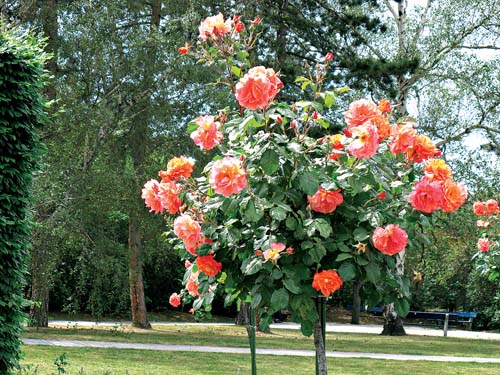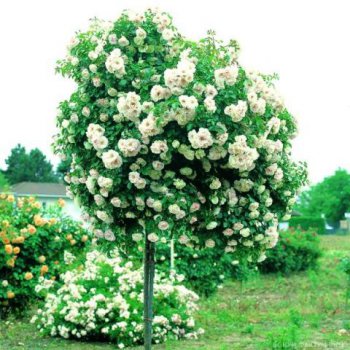Stambling roses are unique plants that give the flower beds a certain height and serve as the center of the overall composition. They can be used to decorate vases, as well as courtyards and summer flower beds.
Content
Varieties of stambling roses
Stambling roses are not a certain variety of roses, but an ordinary type of plants that are grafted on a long stem. That is why to create an elegant garden composition, it is recommended to plant a number of stramb and bush forms of the same variety.
Sometimes such cultures are grown on a support in the form of an umbrella, but experts believe that they look prettier without support. In any case, the stramblastic wreling roses, whose screens are often hanging to the ground, form an incredibly chic canopy.
For the creation of stammer cascade roses, gardeners are used by soil grades (Grouse and Nozomi). At the same time, such forms can be obtained from shrub, which have arcuate powerful shoots (Ballerina and Canary Bird).
As for mobble roses, they always produce an unforgettable impression when they are planted alone among the lawn.
Stambal Patio Roses are dwarf roses Floribunda, growing on the stamps of 75 cm height. They wonderfully look in small courtyards, at the entrance to the house and on a well-lit porch.
Roses suitable for a strap
Not all varieties of such plants are equally suitable for this purpose, since in addition to lush flowering, they must have the following characteristics:
- have a symmetric form (mold or compact);
- have a certain nature of growth, which would allow artificially support their form.
Plant data classes depending on the height of the stan
1. Purchase very high strabamous forms.
The vaccination of such roses is made at an altitude of 1.5 m, applying plenty strollers (alaimbins, rabblers, etc.). The flexible long branches of these plants are hung gracefully, creating an unforgettable decorative effect.
2. Full high straps.
In this case, the grafted rose is placed at a height of 0.90-1 m.
For this type of drafts, Floribund is used, some types of chain-grained roses, the average roses of Cordesia and other species that are best adapted to local climate conditions.
3. Halfwubs or middle straps.
The height is 70-80 cm. At the stamps, more often grown with a variety of roses, but more stripped types are allowed.
4. Low straps.
In this case, Krone Rosa is located at an altitude of 0.40-0.60 m. These varieties of roses are appropriate here as poliant, floribunda, as well as plenty and stripped forms of miniature plants (Orange Maiandin, Maidi, Red Casqueid).
As for miniature slaughterhouses (Cricari Yello, Pink Hzsa, Bentam), then for them you can use strains from 25-30 cm high.
Landing of stambling rose
Landing a strain should be started in March or in early May - it all depends on climatic conditions.
To begin with, they dig a large pit, which will exceed the sizes of the earthen com. The landing depth must be created such that the start of the seedling of the strambl rose and its root neck were in the soil from 60-70 cm. It is also necessary to create a support that will depend on the size of the stock. The gap between the strambered plants must be left by about 1 m from each other.
Recommendations for landing Staffes that have an open root system:
1. Lower vaccination, which is produced in the root neck, should be half in the ground and half above its surface. As for miniature strabs, they have no lower vaccination.
2. If your seedlings have white stretched shoots from the kidneys, they should be offset.
3. When landing slightly tilt the stack towards the lower vaccination. After placing the support, delay the strab to it and tie so that the seedlock takes the vertical position.
4. At a distance of 2.5 cm from the barrel of the Stamb stuck in the soil support. The latter should be high enough to subsequently keep the crown.
5. Next, place the wet leaves around the crown. If it is wide enough, then neatly tie the shoots with a synthetic rope. Instead of leaves, you can apply moss (sphagnum), which is excellent for such purposes.
6. Wrap the crown with burlap cloth, the top of which is fixed on the support, and the bottom under the crown. Regularly produce moisturizing moss or leaves.
Check how the plant development is being developed every day, slightly raising the material. As soon as the kidneys start germinate, it will be possible to remove everything too much.
Support for Stamb
The choice of type type always depends on the size of the plant. For small strabs, it is enough to use a steel twist. For more large strabs, it is better to use plastic green supports. They are stuck deep into the soil in such a way that they rise above the upper branches.
The simplest method of binding roses to the support is a tape, since it is rather strong and not crashed into the barrel. When tapping, it is necessary to apply the material with adhesive side from the barrel, and the second layer, on the contrary, to the trunk.
The stack is fixed in two places: under the crown and at the base of 10 cm from the ground.
In the event that the strab grows on a windy plot, to the support should also be tested and the main shoots of the crown.
Trimming Stumbus Rose
Recommendations:
- pruning plants produce a knife, a secateur or garden saw;
- in the 1st year after disembarking, it is not recommended to trim a rose, with the exception of some damaged shoots;
- in summer, buds should be removed to develop strong stalks;
- for the second year, dead shoots are also removed, and trimming is created solely to maintain the form;
- since the 3rd year, removal of dead shoots is carried out, as well as those that grow inside the crown;
- delete all shoots that develop below the places of vaccinations in the Stack.
There are three types of trimming strains:
1. Spring.
In the spring, sanitary pruning of plants is usually carried out, which is the removal of broken, precipitant, thin and damaged branches, as well as the growing stamps.
As for the long and short trimming, it is carried out in accordance with the variety of roses. According to the second type, with shorter shoots, there are 3-6 strong, young and unbranched trunks. At the same time, their length should be from 5-15 cm.
Long trimming involves the preservation of the length of the row of the strain. In this case, there is a slight cutting of the ends by 10-15 cm.
Remember that the procedure for circumcision a strain must be finished even before the leaf is dissolved.
2. Summer.
In the summer, with a cut of roses in a vase or on the cuttings, it should be left on the stem 3-4 of the lower sheet. It is also necessary to remove the sworded heads so that seeds do not occur.
3. Autumna
In the fall, the petals are usually removed, and the rose is not trimmed, because the ends can be amazed and bad to start healing.
After each trimming, it is necessary to protect the rose crown from drying into the wind and the sun. To do this, use cotton wool, moss and leaves that are located inside it. It is they who protect young shoots from burns, thereby provoking the growth of the kidneys. From above, the plant is wrapped with a fabric bag. Next, within 2 weeks, it is necessary to moisten the surface of the material using a spray gun.
Please note that the development of the kidneys can occur before, so periodically check the state of the rose, lifting the bag. After the specified period, remove the material in the evening time or cloudy day to teach the plant to changing environmental conditions. If you opened the seedling of the rose strain and noticed the faded ends, then they should be cut off.
Stammer Rose: Care
Care for such a rose is about the same as for ordinary bush, however, is slightly different depending on the variety of plants. Culture It is necessary to regularly water, protect the spring from drying out, create a weeding, loosen the soil, and also to make fertilizers in a timely manner, struggle with pests and strengthen the plant for the winter.
Care recommendations:
- watering is recommended for the most base in the morning or evening;
- you can also climb the area of \u200b\u200bwatering so that the moisture is slower than evaporated;
- in the autumn period, the rose is not watered, thereby stimulating the ripening of wood;
- fertilizers should be made in spring even before the leaf is dissolved;
- at the end of the summer, the soil fertilizer should be suspended;
- in the fall, it is possible to start packing a rose with potash fertilizers that will help to ripen wood and prepare a plant to the cold;
- in the spring and summer, stramb roses need to be processed as prevention by chemicals (fungicides).
Stammer rose. Landing, growing and caring video:






























